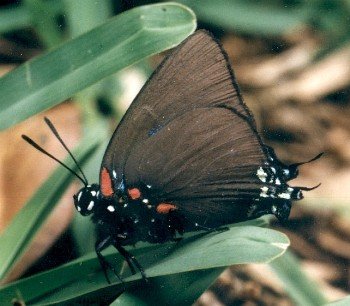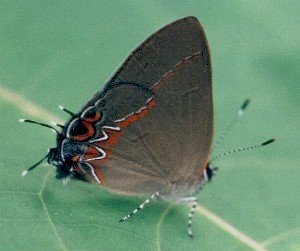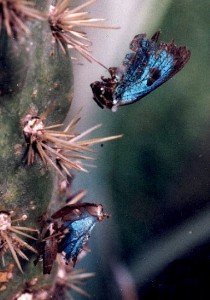
Many of our butterflies are rather small, but they are interesting nonetheless. I've often seen various species of hairstreak in our yard and garden, and they are not too difficult to approach if one is careful and moves slowly.
The two species pictured here are rather common and I've seen them on several occasions. The great purple hairstreak, pictured at right, is the larger and a bit more skittish than smaller species. It is also very beautiful because its upper wing surfaces are a brilliant metallic blue.

While the caterpillars are pretty small and I'm not even sure what they look like, their host plants are generally cited as mistletoe for the great purple and sumacs and oaks for the red-banded.
 The red-banded hairstreak, left, is one that I've watched closely several times. It has the most interesting habit (which is probably pretty common among hairstreaks) of moving its lower wings alternately up and down, drawing attention to the "hairs" that project at the back. They look just like antennae at first glance and I've sometimes mistaken which direction an individual was facing. The projections serve the purpose of fooling predators into attacking the back of the butterfly instead of its head, and moving them up and down while the real antennae remain still is a sure way to increase the deception. This obviously works pretty well as I've found some butterflies with ragged wings but they are still flying around. A bit of wing is much more expendable than the head.
The red-banded hairstreak, left, is one that I've watched closely several times. It has the most interesting habit (which is probably pretty common among hairstreaks) of moving its lower wings alternately up and down, drawing attention to the "hairs" that project at the back. They look just like antennae at first glance and I've sometimes mistaken which direction an individual was facing. The projections serve the purpose of fooling predators into attacking the back of the butterfly instead of its head, and moving them up and down while the real antennae remain still is a sure way to increase the deception. This obviously works pretty well as I've found some butterflies with ragged wings but they are still flying around. A bit of wing is much more expendable than the head.
The final picture shows that not all defensive strategies are foolproof. These upper wing remains of a great purple hairstreak were all that was left of some bird's meal.
| 

 The red-banded hairstreak, left, is one that I've watched closely several times. It has the most interesting habit (which is probably pretty common among hairstreaks) of moving its lower wings alternately up and down, drawing attention to the "hairs" that project at the back. They look just like antennae at first glance and I've sometimes mistaken which direction an individual was facing. The projections serve the purpose of fooling predators into attacking the back of the butterfly instead of its head, and moving them up and down while the real antennae remain still is a sure way to increase the deception. This obviously works pretty well as I've found some butterflies with ragged wings but they are still flying around. A bit of wing is much more expendable than the head.
The red-banded hairstreak, left, is one that I've watched closely several times. It has the most interesting habit (which is probably pretty common among hairstreaks) of moving its lower wings alternately up and down, drawing attention to the "hairs" that project at the back. They look just like antennae at first glance and I've sometimes mistaken which direction an individual was facing. The projections serve the purpose of fooling predators into attacking the back of the butterfly instead of its head, and moving them up and down while the real antennae remain still is a sure way to increase the deception. This obviously works pretty well as I've found some butterflies with ragged wings but they are still flying around. A bit of wing is much more expendable than the head.